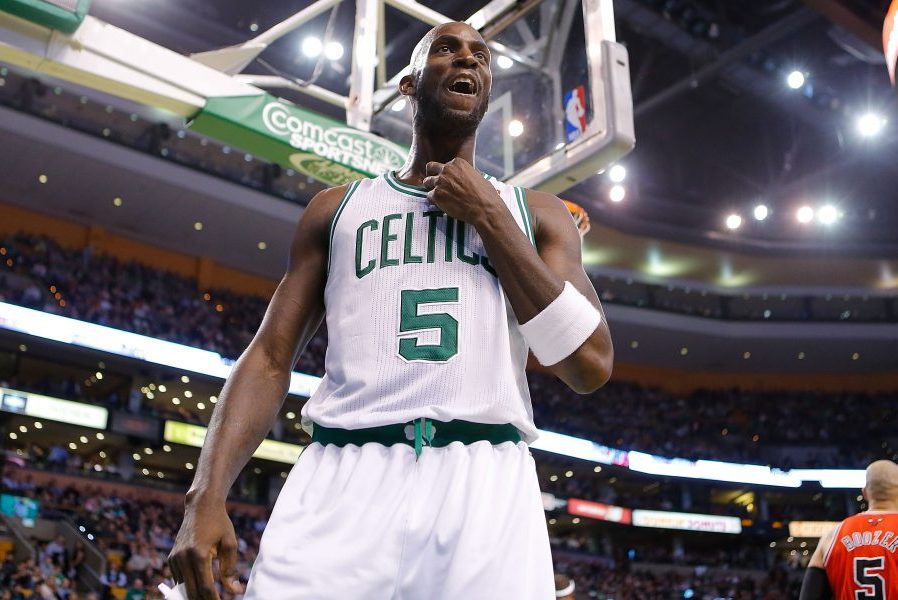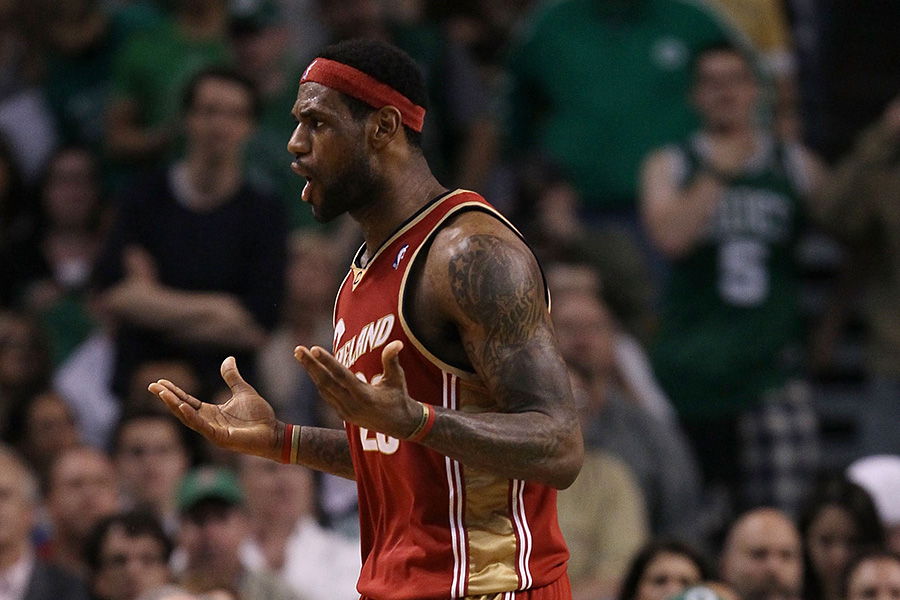The night the Celtics broke LeBron
By Sean Sylver, 98.5 The Sports Hub
The Boston Celtics have faced LeBron James in the NBA Playoffs five times over the the past decade. Five times, they’ve gone down in defeat. Two very different Boston teams (in 2012 and in 2018) took him to seven games.
The King always prevailed.
But 10 years ago on Wednesday, the Celtics “broke” LeBron.
That’s the Kevin Garnett version, and plenty of hoops pundits criticized the freshly minted Hall of Famer for that take.

“We didn’t give a [expletive] about LeBron.” –Kevin Garnett on the The Bill Simmons Podcast (Photo by Jared Wickerham/Getty Images)
Then the Celtics built their new Big Three and booted LeBron in seven games in 2008. After 66 wins and a top seed in 2009, the Cavs fell to the Magic in the Conference Finals.
“That team just wasn’t built for the playoffs against good teams,” muses Brian Robb of the Boston Sports Journal and 98.5 The Sports Hub. “Not enough secondary scorers, shot creators. LeBron knew he needed help to beat anyone good.”
The Characters

LeBron James’ supporting cast in 2010 was a far cry from what he had later. (Photo by Gregory Shamus/Getty Images)
Before James aligned himself with names like Davis, Irving, Love, Wade, or Bosh, flanking him were Mo Williams, a fading Antawn Jamison, and a 37-year old Shaquille O’Neal.
With James set to become a free agent during the summer of 2010, that roster was going to have to be good enough to win, or at least convince James it was worth continuing his pursuit of a championship in Northeast Ohio.
Meanwhile, the 2010 Celtics were in the third year of what Danny Ainge had previously described as a three-year window. They’d raised the Larry O’Brien Trophy the very first season, but saw their plans for a repeat crumble when Kevin Garnett succumbed to a knee injury.
With Garnett down, third-year guard Rajon Rondo made the leap during the 2009 postseason, nearly averaging a triple double. As KG healed, Ainge added four-time All-Star and NBA champion Rasheed Wallace and versatile swingman Marquis Daniels to an already talented roster.
Wallace immediately compared his new team to the 1996 Bulls, who’d set an NBA record with 72 wins.
“I think we can get that Bulls record,” Wallace proclaimed during training camp. “You know we have the talent for it. We have the will for it and … I think we have the defense for it.”

Rasheed Wallace was confident about the Celtics’ chances in 2010. (Photo by Elsa/Getty Images)
The Green started 23-5, thumping the defending Eastern Conference champion Magic on Christmas Day.
But midseason injuries to Garnett and Paul Pierce prompted a three-month malaise where the Celtics were a .500 team, slipping to the fourth seed entering the playoffs.
“KG wasn’t himself and there just wasn’t a lot of consistency at both ends of the court,” Robb remembers. “I had a belief they could ‘flip the switch’ when it mattered but there was no confidence about that. The hope was that the vets – especially Sheed – would turn it on when the games actually mattered.”
And just like that, the Celtics started the postseason by holding first-round opponent Miami under 80 points in each of the first two games. Boston cruised in five.
“(Dwyane) Wade was playing out of his mind in that series and the C’s still took care of business easily,” recalls Robb.
Five-Game War

Paul Pierce celebrates the Celtics’ series win over the Heat in the 2010 NBA Playoffs. (Elsa/Getty Images)
Meanwhile, the Cavs took ascendant superstar Derrick Rose’s best shot (27 points per game) and neatly dispatched the Bulls in five games, setting up a second-round clash with Boston.
The 61-win Cavs were heavy favorites. As expected, they took Game 1 at home, with James pouring in 35 points on 12-for-24 shooting. Williams had 20, including a startling third quarter jam over Pierce as part of a dominant closing stretch.
But the Celtics roared back to take Game 2 and wrest home court advantage headed back to TD Garden. Boston’s depth was on full display as Ray Allen scored 22, Garnett had 18 with 10 rebounds, Wallace chipped in 17 off the bench, and Rajon Rondo tied Bob Cousy’s Celtics playoff record with 19 assists.
Meanwhile, Williams shot just 1-for-9 and James was limited to 24 points (six below his average) as he attempted just 15 shots. Many speculated about the condition of James’ elbow, which had pushed the 25-year old to shoot a left-handed free throw in the finale of the Chicago series.

Paul Pierce gets in for a basket between Mo Williams, LeBron James, and Antawn Jamison during Game 2 against the Cavs in the 2010 NBA Playoffs. (Photo by Gregory Shamus/Getty Images)
The elbow, like James’ impending free agency, lingered over the entire affair. 10 years ago, LeBron’s media savvy wasn’t quite where it is today (though one could take or leave his “Taco Tuesday” videos). Further, New Yorkers thought he was coming to save the Knicks, so you had the behemoth New York media all over the place.
James was asked about the elbow after every game. It wasn’t an excuse, he said, but he failed to extinguish the speculation. While it was deemed a minor impediment in games the Cavs won, it was a visible hindrance during games the Cavs lost. While X-rays and an MRI reportedly revealed no damage, James had clearly altered his on-court approach.
“[LeBron] said he wasn’t using the elbow as an excuse, but the elbow did limit him some,” notes Brendan Bowers, Cleveland fan and author of the books Cleveland Is King and LeBron James vs. the NBA.
After three days of rest, James rumbled to 21 first quarter points in Game 3. He finished with 38, Jamison chipped in 20 and 12, and the Cavs handed the Celtics their worst playoff home loss ever, 124-95.
Pierce called the loss “embarrassing.”

LeBron James reacts after colliding with Paul Pierce during Game 3 of the Celtics-Cavs series in the 2010 NBA Playoffs. (Photo by Jim Rogash/Getty Images)
Rondo took over in Game 4. The Celtics evened the series as the point guard scored 29 points with 18 rebounds and 13 assists – marks only previously achieved in the same postseason game by Oscar Robertson and Wilt Chamberlain. It was clear that Boston’s gritty, veteran-driven group had a thriving young artist in their midst.
“[Rondo] runs our team and has complete control of our team,” said head coach Doc Rivers. “Now we rely on him to win.”
Game 5 unpredictably swung the series, and with it, the future of the NBA.
The Celtics shot 55 percent – Allen scored 25, Pierce chipped in 21, and the Celtics handed Cleveland their worst home playoff loss in franchise history, 120-88. The elbow talk reached a crescendo after James shot 3-for-14 for a meager 15 points.
The free agency talk was even louder, as the future of Cleveland hoops had seemingly come down to one game.
“With ‘The Decision,’ there was some optimism, but you felt like LeBron was leaving Cleveland before he showed up with Kanye at the Boys & Girls Club,” Bowers remembers. “Meanwhile, fans went into Game 6 with genuine hope -maybe even a belief – that the Cavs were going to win, force a Game 7, and keep the dream alive.”
A Broken Superstar

The Celtics’ huge win in Game 5 forced the Cavs into a corner in Game 6 of their 2010 series. (Photo by Elsa/Getty Images)
LeBron triple-doubled with 27 points, 19 rebounds and 10 assists. But he was 8-for-21 from the floor and committed nine turnovers. Meanwhile, Garnett had 22 points and 12 rebounds, Rondo posted another command performance with 21 points and 12 assists, and the Celtics punched their ticket to the Conference Finals with a 94-85 win.
“KG just destroyed Jamison (2-for-10 in Game 6) in that series, if memory serves me right,” says Robb. “That, combined with Rondo running circles around Mo Williams, felt like the difference.”
“It always just felt like C’s had a far better balanced roster and supporting cast compared to LeBron in that era. Delonte West, Anthony Parker and Jamison just weren’t going to beat Pierce, KG, Ray, and Rondo without LeBron going nuts.”
James didn’t wait to reach the locker room before removing his Cavaliers jersey for the last time (until 2014). He was philosophical at the postgame podium: “A friend of mine told me, ‘I guess you’ve got to go through a lot of nightmares before you realize your dream.’ That’s what’s going on for me individually right now.”
“When [James] tore off his jersey [in the tunnel after the game] you knew he was leaving,” Bowers reflects.

“A friend of mine told me, ‘I guess you’ve got to go through a lot of nightmares before you realize your dream.'” (Photo by Elsa/Getty Images)
So did the Celtics break LeBron? He at least needed to take the proverbial cartridge out of the NES, blow on it, and put it back in.
Two postseason losses to Boston in three seasons likely helped usher him into the welcoming arms of Wade, Bosh and Pat Riley – a seismic shift in the Eastern Conference from which the Celtics never recovered. Their seven-game loss to the Lakers in the 2010 Finals remains their last appearance in the league’s June showcase.
“I think it was more bad roster management by the Cavs than the Celtics in that era that broke him,” says Robb.
“Whether it did or not, that loss was the beginning of the end for LeBron and the Cavs,” Bowers laments. “But history also suggests the franchise was in desperate need of a reboot anyway. If LeBron didn’t leave for South Beach, the Cavaliers wouldn’t have added Kyrie Irving, Tristan Thompson or the Andrew Wiggins No. 1 pick that was traded for Kevin Love.
“Game 6 was all part of the process.”

“Whether it did or not, that loss was the beginning of the end for LeBron and the Cavs.” (Photo by Elsa/Getty Images)
James, of course, returned to those reconstituted Cavaliers in 2014, leading them to their first NBA title in 2016.
In the words of LeBron himself (per cleveland.com):
“I understood at that point in time that in order for me to compete for a championship and get to that next level, I had to figure out and get with some guys that could be on the same level as Paul, Ray, (Rajon) Rondo, KG and those guys.” James said. “I just didn’t feel like … to do it here, I was out calling guys in the summer time, trying to get guys to come here and guys just continued to decline offers from us.”
“And then at that time we didn’t even have any money to go get anybody. I knew personally that D-Wade was a free agent, I knew Bosh was a free agent, I knew Amare (Stoudemire) was a free agent, I knew Carlos Boozer was a free agent, so I knew I had to try and get some guys to try and get Boston, man. That was my whole mindset.”
Call it what you will, but the rest is history. The NBA is a very different league – for many reasons – after 10 years. The events that transpired in Boston and Cleveland during the first two weeks of May 2010 played a significant role.
Sean Sylver can be heard on 98.5 The Sports Hub. Talk hoops with him on Twitter @TheSylverFox.



